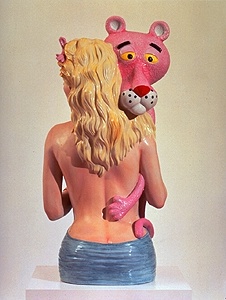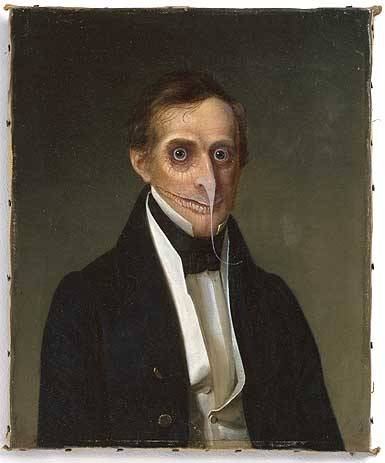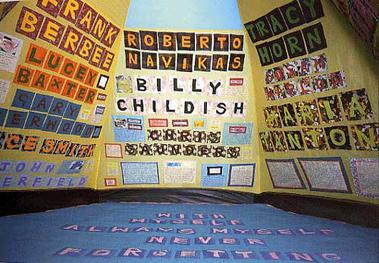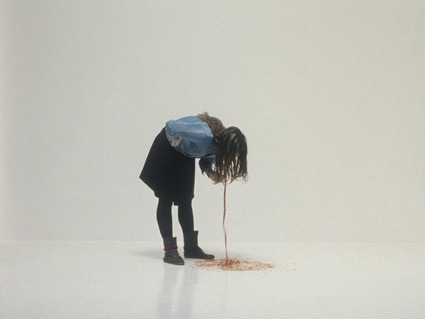As we have been asked to create a book showing deep understanding into a particular subject, I thought I would base my book on the essay that I wrote on the value of Fine Art.
I want to follow my opinionated theme in my essay, and create something that almost "takes the piss" out of what we class as Fine Art nowadays, and how it's valued. I think creating something that holds it's own form of pretentiousness as well as looking like a piece of contemporary art...
I have decided to work with contemporary artists, such as Damien Hirst and Jeff Koons, as I feel that these artists are the ones who I would completely question them on how their artwork is so valuable.
Research Into Contemporary Artists:
Damien Hirst
I am quite opinionated on work created by Damien Hirst, mainly due to the fact he doesn't really need to hold any type of skill himself to create the pieces that he creates. A lot of the time Hirst will hire others to paint dots for him, or cut cows in half an embed them in formaldehyde. I think, conceptually, he's a good artist. However, I feel that he needs to add his own skill into the concept to make his pieces actually contain value (rather than treating the industry like a business and way of making money), as I feel he only receives the money he does for his work, simply because it's been branded with his name. I think a lot of people have their opinions on Hirst - he's a bit like marmite; you either love him or you hate him.
Jeff Koons
I'm not really sure what to think about Jeff Koons. In a way, I dislike him, but it's mainly due to the fact that he's one of Hirst's main inspirations. I prefer him to Hirst, in the fact that he actually uses his own skill to create his pieces. However, I really hate how kische all of his work is, and how none of it really holds any elegance or class. It seems to me that he just thinks up something vulgar, and creates it without hesitation.
The Chapman Brothers
I think that The Chapman Brothers' work is far too outrageous for my liking. It seems that they enjoy creating something just to shock the public and cause a stir. One thing that I credit them for, is the fact that they do use their own artistic skills to create their pieces, however I think that the ideas behind them are a bit too outgoing, and not really the kind of artwork that I like to view in exhibitions etc.
Rachel Whiteread
After looking through a lot of Whitread's installations, I can say I do find them quite interesting as she works in a way that I've never really experienced before I heard about her. However, I still feel as though a lot of her work focuses more on the concept behind the idea, rather than the way that it is produced. I feel as though she just stumbled upon the use of concrete as a substitution or mistake when trying some original ideas possibly, and after that happy accident, she really has stuck by it. All her work is created from the same materials and she always uses white. It's quite bizarre, but intrigues me all the same.
Tracey Emin
I can't quite get my head around what Tracey Emin is all about. She really couldn't care less how people think of her, and happily lets the world know about her sex/personal life and her innermost curiosities. A lot of her work is vulgar and disgusting - she tends to make herself seem quite whorish and a bit of a nymphomaniac. I find some of her sketches quite interesting, purely because of how far from perfect they always seem to be, however I really am not keen on her installation work or how much she loves to get naked in front of the camera for her own art.
Martin Creed
Martin Creed creates a variety of installation and performance artworks - he particularly likes to work with how humans interact and engage with his work. I've actually been to one of his summer exhibitions at the Tate in St Ives, where there was literally a room filled with white balloons that you walked through. As I was taking part in walking through an entirety of ballons, I found it incredibly fun, however I didn't understand the point in it then, and still don't understand it now (the below images are my own photos of the exhibition)...
Anish Kapoor
One very obvious element of Anish Kapoor's work, which always stands out, is the constant use of the colour red. He loves red. There are only a few installations that Kapoor has created that aren't in red, which is probably his signature way of working - to help him stand out in the crowd against the other installation artists of his time. I don't really like Kapoor's work. A lot of it I find seems to be really messy and hard to work out. Usually I can appreciate installation art, but when it comes to Kapoor's work I never know where to look or how to even start to understand what he is trying to achieve. I know that he is very proud of where he's from, which is a huge influence for the colour red within his work, however the rest of it just doesn't make much sense to me.
Michael Craig-Martin
The most particular piece of work I can't stand by Michael Craig-Martin would be this: 'Oak Tree'. Even when interviewed, he responds in really ponsey and pretentious manners, trying to convince the interviewer that he has, in fact, changed the matter of the glass of water into an oak tree, without the actual aesthetics of it changing what so ever. I think, in a way, he's quite clever, as he has managed to convince millions of people that his work is brilliant, however I find his work to be ridiculous. I don't even like his 'graphic-style' drawings.
I find them really out dated and disgusting. The colour choices are hideous, and the simple line art doesn't work with the rest of it.
Cornelia Parker
I'm not really sure what to think about Cornelia Parker's work. An obvious theme that runs throughout all of it is the fact she likes to destroy things, and then suspend them from the air so that they float in the room. I watched a documentary on her a few years ago, and the way that she bulldozed instruments and blew up sheds seemed way more exciting than her actual final installations!
Joseph Kosuth
I've only recently been introduced to Kosuth's work, so haven't developed a full opinion on him yet. However, I can say that I don't particularly enjoy a lot of what he produces. I think that the objects he photographs and finds the dictionary definition for are extremely pretentious and show a great focus on the idea itself, rather than the way of communicating what he has to say properly. However, saying that, I do quite like his typography made out of LED lighting, for some reason. It's not exactly the best typographic choices or styling, but something about it interests me, and the room with the words in arabic glowing around the top section of a dark room is also extremely interesting and different.
✿✿✿✿✿✿✿✿✿✿✿✿✿✿✿✿✿✿✿✿✿✿✿✿✿✿✿✿✿✿✿✿✿✿✿✿
What Is A Book?
I have decided to question what a book is, and how I can produce something that you can follow in a similar way to a book, but through a process in which I won't be using ordinary book methods or materials.
I have decided to approach this question in a contemporary style. I want to create something that makes the viewer question what they are viewing, and I also want my "book" to be quite pretentious in it's own unique way.
My initial idea was to collect various methods of creating typography through history, for example different materials they used to make ink when cave painting, or materials in which people have carved into to create letters. I thought, once collected, I could put these various materials within small glass bottles within a cabinet, with a clear simplistic labelling system so that you know what is within the bottle. However, the problem with this concept, is I don't think it really relates to any contextual studies in which we have learnt during our context of practice module. We had one lecture on typography, and I don't really think that would be enough information for me to play with.
Therefore!
I have decided to keep the idea of collecting information and placing it in small glass bottles with simplistic labels. But the information that I'll be collecting, will be more fine art related. I decided to look into contemporary artists, and their relations between the pieces of art that they produce and the title in which they give them. Whenever I see a piece of contemporary artwork, it often has some bizarre and pretentious title to it, that you don't quite understand. I will collect a variety of these outrageous titles for the labels, and then visually communicate the titles themselves within the glass bottles. I think that this would be quite ironic and opinionated on the subject of contemporary artwork, and I want to make sure that the visual communications of the titles are as literal as they possibly can be so that when you glance upon each bottle, you wouldn't associate the contents with the original pieces of art.
✿✿✿✿✿✿✿✿✿✿✿✿✿✿✿✿✿✿✿✿✿✿✿✿✿✿✿✿✿✿✿✿✿✿✿✿
Change of Idea...
NEW IDEA.
After the crit with Fred, I was told that I was giving myself far too much work and being rather ambitious for the time set. Therefore, I was asked to come up with an idea that was more reasonable and more achievable within the few weeks that we had left. This became a challenge. I really couldn't think of how I could change my idea to something that was just as strong, but a lot less work to handle.
After sitting there for a while, and talking to my mum about things I could do, I came up with the idea of portraying the artists in a way that still takes the piss, but does this through how they talk about themselves, rather than completely how others see them.
I then went through this idea with Joe Leadbeater, who gave me the following feedback:
- try and think of a suitable audience - if you create it for people who love art, how could you influence them that what conceptual artists create isn't as valuable as it seems?
- possibly create the book for the Royal Academy of Arts, or the Saatchi Gallery as this would give it a name and make it seem more believable and trustworthy.
- don't use the straightaway obvious creations from each artist - try to mix it up a little bit.
- try and think of a witty and clever way of twisting what the quotes actually mean.
After my little idea crit with Joe, I felt a lot more confident and thought that my idea was actually starting to go somewhere! I then had a small tutorial with Fred, where I gave him the following idea:
To create a fake exhibition leaflet, for the Tate Modern or Tate Britain, with the context being minimalist and featuring ironic quotes from each conceptual artist, as well as a few images of their work.
Fred was pleasantly surprised by my new, more achievable output and gave me some feedback to work upon as well:
- have a look at the Turner Prize - maybe you could use artists who have won that, or use that for the branding of the publication?
- the quotes themselves work really well for the content and opinion on the work.
- Photographs as well as possible laser cutting etc - give yourself the options but only work with what is achievable in the time set.
- Don't go for the obvious works of art by each artist.
- Remember that it doesn't have to be bound - could be handed in as leaves of information.
- Throw away anything that is unnecessary.
I felt a lot happier with my idea after speaking to Fred, as he seemed pretty keen on what I was inspiring to do and set out to find a few ironic quotes by the artists in mind...
"It was like gold because it was me, but, really it's shit" - Damien Hirst
"I don't want to spend the rest of my life in the bedroom like some people who just go to bed and never get out again" - Tracey Emin
"I think the essence of the, the, of the Oak Tree is the fact that the proof that it is what it claims to be is exactly the same as the proof that it isn't" - Michael Craig-Martin
"We wanted to sugest inevitability, fate, the infinite quality of any regress, the absurdity of counterfactuals - the lunacy of the idea that one person can change the world" - Jake Chapman
"I thought: wow! A spoon that has lost it's spoon-ness" - Rachel Whiteread
"There's such freedom about being an artist... You're not accountable - you're this renegade thing" - Cornelia Parker
✿✿✿✿✿✿✿✿✿✿✿✿✿✿✿✿✿✿✿✿✿✿✿✿✿✿✿✿✿✿✿✿✿✿✿✿
I found these two books on Damien Hirst's work in the library and was instantly inspired. After reading through them, I knew exactly how I wanted my publication to look like, as I loved the minimalist feel to both of his books. I really liked the very minimal amount of text that he used for each piece of art, and the way the book intended to emphasise his pieces, not what they were about or the names of them. The book 'No Love Lost' was my favourite out of the two, and became a huge influence when designing my publication.
✿✿✿✿✿✿✿✿✿✿✿✿✿✿✿✿✿✿✿✿✿✿✿✿✿✿✿✿✿✿✿✿✿✿✿✿
DESIGN DEVELOPMENT
✿✿✿✿✿✿✿✿✿✿✿✿✿✿✿✿✿✿✿✿✿✿✿✿✿✿✿✿✿✿✿✿✿✿✿✿
FINAL PUBLICATION
✿✿✿✿✿✿✿✿✿✿✿✿✿✿✿✿✿✿✿✿✿✿✿✿✿✿✿✿✿✿✿✿✿✿✿✿
I am extremely proud and surprised at what I managed to achieve, considering all the dilemmas I encountered on the way, and the little time I left myself in the end to produce the publication. I really love the final outcome - it definitely has a Fine Art twist about it, and is cleverly ironic in the way I decided to bring the idea across to the reader.
I love the use of different stock, as the tracing paper helps make the book look and feel elegant, whilst also sticking to the very minimalist approach to design.
If I were to recreate the publication, I would definitely reconsider the binding method. Although coptic stitch looks elegant and beautiful down the spine of the book, my stock choice was far too delicate and the pages of the book (mainly the tracing paper pages) constantly ripped whilst I was binding it. This was extremely frustrating, so in the future I would definitely avoid a coptic stitch when using tracing paper. This also meant that the alignment was slightly off with the quotes, so I would have to definitely consider a type of binding that made sure that everything was aligned perfectly...
I think I would also possibly reconsider the front cover a little more, as something about it doesn't quite fit in with the contents of the book - maybe the actual layout of the title and information on the back could have been more interesting, and designed in a way that was consistently reflecting the layout of the inside of the publication?
Even with all these faults, I feel that I have produced something, which I find, extremely effective and I love the aesthetics and feel to the final publication. I just wish I had given myself that little bit more time so that I could experiment a bit more with printing, stock and binding methods, and then produced something of higher quality!






















































































































































































